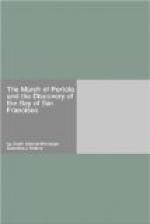On Saturday, November 4th, being the day of San Carlos Borromeo, in whose honor they had come to establish a royal presidio and mission in the Port of Monterey, and also the day of the king, Don Carlos III (que Dios guarde), the holy sacrifice of the mass was celebrated “in this little valley, beach of the Port (without the least doubt) of my father San Francisco.” The men feasted liberally on the mussels which abounded on the nearby rocks, and which were pronounced large and good, and, in better spirits than they had been for some time, they took up their march at one o’clock in the afternoon. Proceeding a short distance up the beach, they turned into the mountains on their right, and from the summit beheld the immense estero o brazo del mar. Then descending into the Canada de San Andres, they turned to the south and southeast, and traveling two leagues camped in the canada at the foot of a hill, very green with low brush, and having a cluster of oaks at its base. The next two days they traveled down the canada, coasting the estero, which they could not see for the low hills (lomeria) on their left, noting the pleasant land with its groves of oak, redwood (palo colorado), and madrono. They saw the tracks of many deer and also of bears. The Indians met them with friendly offers of black tamales and atole, which were gladly received by the half-starved Spaniards. They begged the strangers to go to their rancherias, but the governor excused himself, saying that he must go forward, and dismissed them with presents of beads and trinkets. On the 6th, they reached the end of the canada, which suddenly turned to the east, and saw that the estero[32] was finished in a spacious valley. To the canada they gave the name of San Francisco[33]. Traveling a short distance towards the east, they camped on a deep arroyo, whose waters came down from the sierra and flowed precipitately into the estero. They were on the San Francisquito creek, near the site of Stanford University[34].
Having failed to get through to Point Reyes by the ocean beach route, Portola now sent Ortega around by the contra costa giving him four days in which to explore the country and find the port containing the supply-ship.
Ortega with his exploradores, guided by some friendly Indians from the neighboring rancherias, set out after noon on November 7th and returned in the night of the 10th. He reported that he had seen no sign of port or ship, and was convinced he had not understood the information the Indians had tried to convey to him, and that the port of Monterey could not be in advance. They also reported that the country they had seen towards the north and northeast was impassable for the expedition, for the reason that the Indians had burned the grass and, in addition, were hostile and would dispute the passage. They said that they had encountered another immense estero on the northeast (Carquinez Strait), which also ran far inland and connected with the one on the southeast, and that to double it would take many leagues of travel[35].




